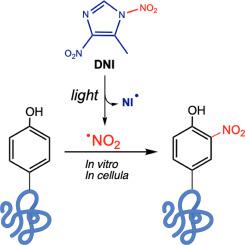当前位置:
X-MOL 学术
›
Free Radical Bio. Med.
›
论文详情
Our official English website, www.x-mol.net, welcomes your
feedback! (Note: you will need to create a separate account there.)
Photochemically-induced protein tyrosine nitration in vitro and in cellula by 5-methyl-1,4-dinitro-1H-imidazole (DNI): synthesis and biochemical characterization
Free Radical Biology and Medicine ( IF 7.1 ) Pub Date : 2023-09-30 , DOI: 10.1016/j.freeradbiomed.2023.09.038 Natalia Rios 1 , Adrián Aicardo 2 , Cecilia Chavarría 1 , Rodrigo Ivagnes 1 , Mauricio Mastrogiovanni 1 , Rafael Radi 1 , José M Souza 1
Free Radical Biology and Medicine ( IF 7.1 ) Pub Date : 2023-09-30 , DOI: 10.1016/j.freeradbiomed.2023.09.038 Natalia Rios 1 , Adrián Aicardo 2 , Cecilia Chavarría 1 , Rodrigo Ivagnes 1 , Mauricio Mastrogiovanni 1 , Rafael Radi 1 , José M Souza 1
Affiliation

|
The photochemical nitrating agent 5-methyl-1,4-dinitro-1H -imidazole (DNI) has been recently described as an effective tool for nitrating tyrosine residues in proteins under 390 nm irradiation (Long T. et al., 2021). Herein, we describe the one-step synthesis of DNI from the precursor 4-methyl-5-nitro-1H -imidazole with good yield (66%) and high purity (>99%). Spectral analysis of DNI reveals two maximum peaks (228 and 290 nm) with maximum nitration yields and kinetics occurring at 290 nm. Electron paramagnetic resonance (EPR)- and mass spectrometry (MS)- spin trapping analysis evidenced the formation of nitrogen dioxide (• NO2 ) upon irradiation of DNI, implying the homolysis of the N–N bond in the DNI molecule. Irradiation of DNI at 290, 390 nm, or UVA light (315–400 nm), produced tyrosine nitration, with yields approaching ca. 30% with respect to DNI at 290 nm exposure. Indeed, using alpha-synuclein as a model protein, the main protein post-translational modification triggered by DNI was the generation of 3-nitrotyrosine as shown by MS analysis. Additionally, the formation of di-tyrosine was also observed. Finally, intracellular • NO2 production upon DNI photolysis in bovine aortic endothelial cells was evidenced by the nitration of the tyrosine analog probe p- hydroxyphenylacetic acid (PHPA) and cellular protein tyrosine nitration.
中文翻译:

5-甲基-1,4-二硝基-1H-咪唑 (DNI) 在体外和纤维素中光化学诱导的蛋白质酪氨酸硝化反应:合成和生化表征
光化学硝化剂 5-甲基-1,4-二硝基-1H-咪唑 (DNI) 最近被描述为在 390 nm 照射下硝化蛋白质中酪氨酸残基的有效工具(Long T.等人,2021 年)。在此,我们描述了从前体 4-甲基-5-硝基-1H-咪唑一步合成 DNI,产量高 (66%) 和高纯度 (>99%)。DNI 的光谱分析揭示了两个最大峰(228 和 290 nm),最大硝化产率和动力学发生在 290 nm 处。电子顺磁共振 (EPR) 和质谱 (MS) 自旋俘获分析证明,辐照 DNI 后会形成二氧化氮 (•NO2),这意味着 DNI 分子中的 N-N 键同解。在 290、390 nm 或 UVA 光 (315–400 nm) 处照射 DNI 会产生酪氨酸硝化,相对于 290 nm 暴露下的 DNI,产率接近约 30%。事实上,使用 α-突触核蛋白作为模型蛋白,DNI 触发的主要蛋白质翻译后修饰是 3-硝基酪氨酸的产生,如 MS 分析所示。此外,还观察到二酪氨酸的形成。最后,酪氨酸类似物探针对羟基苯乙酸 (PHPA) 的硝化和细胞蛋白酪氨酸硝化证明了牛主动脉内皮细胞中 DNI 光解后细胞内 •NO2 的产生。
更新日期:2023-09-30
中文翻译:

5-甲基-1,4-二硝基-1H-咪唑 (DNI) 在体外和纤维素中光化学诱导的蛋白质酪氨酸硝化反应:合成和生化表征
光化学硝化剂 5-甲基-1,4-二硝基-1H-咪唑 (DNI) 最近被描述为在 390 nm 照射下硝化蛋白质中酪氨酸残基的有效工具(Long T.等人,2021 年)。在此,我们描述了从前体 4-甲基-5-硝基-1H-咪唑一步合成 DNI,产量高 (66%) 和高纯度 (>99%)。DNI 的光谱分析揭示了两个最大峰(228 和 290 nm),最大硝化产率和动力学发生在 290 nm 处。电子顺磁共振 (EPR) 和质谱 (MS) 自旋俘获分析证明,辐照 DNI 后会形成二氧化氮 (•NO2),这意味着 DNI 分子中的 N-N 键同解。在 290、390 nm 或 UVA 光 (315–400 nm) 处照射 DNI 会产生酪氨酸硝化,相对于 290 nm 暴露下的 DNI,产率接近约 30%。事实上,使用 α-突触核蛋白作为模型蛋白,DNI 触发的主要蛋白质翻译后修饰是 3-硝基酪氨酸的产生,如 MS 分析所示。此外,还观察到二酪氨酸的形成。最后,酪氨酸类似物探针对羟基苯乙酸 (PHPA) 的硝化和细胞蛋白酪氨酸硝化证明了牛主动脉内皮细胞中 DNI 光解后细胞内 •NO2 的产生。

































 京公网安备 11010802027423号
京公网安备 11010802027423号